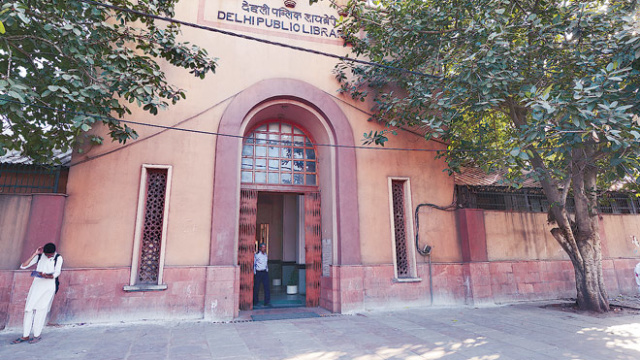A library is an important socio-cultural resource that has the potential to alter and influence the minds of the citizens but under neglect and lack of proper infrastructure are we letting this important public resource decay with time?
Pooja Singal is an Assistant Professor in the Department of Elementary Education, Lady Shri
Ram College for Women, University of Delhi.
‘Space’ is a contested term in India. Public and Private are confused categories. Public schools are not for the masses, but for the classes. The nation is often referred to as ‘motherland’, but the mothers, sisters and daughters do not have the freedom to roam about in public spaces at all hours of the day, as it belongs to fathers, brothers and sons. More than public parks, we need air conditioned malls, so a few can go and buy branded items leisurely, the rest who just want to enjoy the air conditioned space, will be whistled away by the guards. We need a private parking space for our cars inside metro stations, but ‘rikshaws’ should not block the public path outside the station. One such public space that often escapes the public eye is a Public Library.
A public library is a service library maintained on public funds, that allows the general public, irrespective of age, caste, creed, culture, race, religion, community etc, to avail its services at a nominal fee or totally free of cost. UNESCO Public Library Manifesto (1994) has envisioned the role of public library as that of providing resources for education, dissemination of critical information and knowledge needed for good citizenship, becoming the center for cultural, literary and recreational activities for individuals and communities and so on. Public Libraries across the world successfully fulfill these objectives, where a library is often seen as a significant instrument for fostering love for reading, various kinds of exposure-oriented activities and arenas for public discourse by involving civic bodies in reaching out to general public.

The library system in India dates back to 6th Century A.D., with Nalanda, Takshila and Vikramshila University libraries permitting access to its resources only to a few. While, Calcutta Public library, established in 1836 is often referred to as the first public library of the modern kind in India, it too opened its gate to only those, who could pay the subscription fee. It was Maharaja Sayaji Rao Gaekwad III of Baroda, who, impressed by the role played by public libraries in the promotion of education in the United States, introduced free public library system in the true sense in 1907 to further the cause of free elementary education in his own district. However, it remained a one of its own kind of experiment and was not replicated by any other state during that time. Although many village libraries and mobile libraries sprang up between 1930-1940, it could not be developed into a comprehensive system of Public Libraries in India. Post independence, Calcutta Public Library has been renamed as National Library.
Although I have been a frequent visitor to various libraries in Delhi, the true worth of Public/community library system became known to me through two of my recent experiences. The first being, that of a summer camp that my department has been coordinating in two branches of Delhi Public Library, where, in the Chandni Chowk branch, I noticed two brothers very enthusiastically participating in all the activities that we organized in the camp. While interacting with them during these tasks, I got to know that these brothers would come and sit at the gate of the library as early as eight in the morning because their father sold bananas in front of the Purani Delhi railway station. The library opened the doors to another world to them, allowing them to mix with children of different socio-economic backgrounds and learn immensely from this opportunity. For once, boundaries of class and status were blurred, visible only by the clothes worn by the children. I observed one of the boys reading a Hindi story to a convent attending girl, who, in turn, read aloud stories in English to him. Both the brothers literally devoured each and every bit of information given to them and stayed on in the library long after workshop hours. So much was their engagement in the library, that it not detour the younger one of them who wore a pair of torn shorts and sat cross legged for the entire sessions, so no one would notice it. I could see the worth of a library from their perspective.
The other experience is that of visiting a community library run by an NGO, OELP, in Kishangarh block in Ajmer district of Rajasthan. The NGO, working towards the development of two year foundation programme of early literacy and learning in grades 1 & 2 for about 15 schools and community centers in the area, have also set up a network of community based village libraries which aim to facilitate a variety of meaningful engagements with village communities and their local knowledge systems. Managed and run by daughters-in-law of the village, the libraries aim to enhance children’s engagement with books and reading through planned exposure to a variety of books and book based activities including read aloud sessions. It was a sight in itself to observe how a dilapidated old haweli came alive when children started putting up Poem charts, books for display, a trunk full of children’s literature, newspapers made by children to give it the atmosphere of a library and soon groups of children could be seen reading together, the struggling readers being supported by the more proficient ones, in the spirit of ‘Pathan Saathi’ or a Reading Buddy programme conceptualized by OELP. The success of the programme can be gleaned from the fact that each child of this library knew the names and contents of at least hundred children books as I saw them playing ‘Antakshri’, not with songs, but, with the names of the books.
The above two experiences have strengthened my belief that a public/community library system can do wonders in the lives of children, specially, in the literacy development projects. Public libraries have an important role in supplementing formal education and providing for lifelong education to the public, especially in the context of our country, where there is still a large number of first generation learners, who have no educational support at home. Many government schools in Delhi still do not have a well equipped functional library for the students. Delhi is home to thousands of migrants from different states and often from neighboring countries, living under flyovers and other such makeshift arrangements in dismal conditions. Although, Right to Education Act, 2009 mandates access to education even to their kids in schools in Delhi, there is no place to engage in after school social life to channelize their energy in a positive way. Additionally, to reach out to general public, often a platform is needed from where the basic information related to health, education, banking, and other related domains can be disseminated. Thus, public libraries can act as important centers for providing Community Information Services.
To meet some of the challenges stated above, Delhi Public Library was started as a UNESCO project in the year 1951 by the Govt. of India. It was inaugurated by first Prime Minister of India Pandit Jawaharlal Nehru, started as small unitary library in old Delhi, opposite Old Delhi Railway Station. From a single unit, it has since developed a network of Zonal Libraries, Branches & Sub-branches, Community Libraries, Deposit Stations, Mobile Library, Braille library, etc. spread all over Delhi. The library offers services to children and also organizes cultural activities such as lectures, debates, exhibitions etc.
However, a few visits to these branches will make one realize the loopholes in their functioning. And a huge possibility for betterment in their services be it in terms of infrastructure, selection of books or other materials, extension activities or the supporting staff. Government of India has recently taken some concrete steps by setting up a National Mission of Libraries to look at the current status of libraries in India and to recommend measures for improving and strengthening Public libraries, in pursuance of National Knowledge Commission recommendations for sustained attention for development of Libraries and Information Science Sector. We can only hope that the public library services would be upgraded in due time to meet the challenges of digital age and the needs of the general public.
The basis of a democratic citizenry is founded on the premise of mutual understanding and a questioning spirit. It is also based on the citizens’ active engagement in the political and social discourses of the nation. Public libraries can become the meeting grounds for such a dialogue to begin with. I cannot agree more with Maya Angelou when she says “The library helps you to see, not only that you are not alone, but that you’re not really any different from everyone else. There may be details that are different, but a human being is a human being.” and “You can’t be talked down to, belittled, or humiliated in a library. When it looked like the sun wasn’t gonna shine any more, God put a rainbow in the clouds. A library is a rainbow in the cloud.”
The New Leam has no external source of funding. For retaining its uniqueness, its high quality, its distinctive philosophy we wish to reduce the degree of dependence on corporate funding. We believe that if individuals like you come forward and SUPPORT THIS ENDEAVOR can make the magazine self-reliant in a very innovative way.









